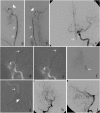Mechanical thrombectomy with solitaire stent retrieval for acute ischemic stroke in a Brazilian population
- PMID: 23295590
- PMCID: PMC3521799
- DOI: 10.6061/clinics/2012(12)06
Mechanical thrombectomy with solitaire stent retrieval for acute ischemic stroke in a Brazilian population
Abstract
Objective: Large vessel occlusion in acute ischemic stroke is associated with low recanalization rates under intravenous thrombolysis. We evaluated the safety and efficacy of the Solitaire AB stent in treating acute ischemic stroke.
Methods: Patients presenting with acute ischemic stroke were prospectively evaluated. The neurological outcomes were assessed using the National Institutes of Health Stroke Scale and the modified Rankin Scale. Time was recorded from the symptom onset to the recanalization and procedure time. Recanalization was assessed using the thrombolysis in cerebral infarction score.
Results: Twenty-one patients were evaluated. The mean patient age was 65, and the National Institutes of Health Stroke Scale scores ranged from 7 to 28 (average 17 ± 6.36) at presentation. The vessel occlusions occurred in the middle cerebral artery (61.9%), distal internal carotid artery (14.3%), tandem carotid occlusion (14.3%), and basilarartery (9.5%). Primary thrombectomy, rescue treatment and a bridging approach represented 66.6%, 28.6%, and 4.8% of the performed procedures, respectively. The mean time from symptom onset to recanalization was 356.5 ± 107.8 minutes (range, 80-586 minutes). The mean procedure time was 60.4 ± 58.8 minutes (range, 14-240 minutes). The overall recanalization rate (thrombolysis in cerebral infarction scores of 3 or 2b) was 90.4%, and the symptomatic intracranial hemorrhage rate was 14.2%. The National Institutes of Health Stroke Scale scores at discharge ranged from 0 to 25 (average 6.9 ± 7). At three months, 61.9% of the patients had a modified Rankin Scale score of 0 to 2, with an overall mortality rate of 9.5%.
Conclusions: Intra-arterial thrombectomy with the Solitaire AB device appears to be safe and effective. Large randomized trials are necessary to confirm the benefits of this approach in acute ischemic stroke.
Conflict of interest statement
No potential conflict of interest was reported.
Figures



References
-
- The World Health Report 2008. Geneva; World Health Organization. 2008
-
- Ministério da Saúde. Mortalidade–Brasil. Óbitos por Ocorrência por Sexo Segundo Causa CID–BR–10. Accessed May 01, 2010.
-
- Christensen MC, Valiente R, Sampaio Silva G, Lee WC, Dutcher S, Guimarães Rocha MS, et al. Acute treatment costs of stroke in Brazil. Neuroepidemiology. 2009;32(2):142–9. - PubMed
-
- Pontes-Neto OM, Silva GS, Feitosa MR, de Figueiredo NL, Fiorot JA, Jr, Rocha TN, et al. Stroke awareness in Brazil: alarming results in a community-based study. Stroke. 2008;39(2):292–6. - PubMed
-
- Massaro AR. Stroke in Brazil: a South America perspective. Int J Stroke. 2006;1(2):113–5. - PubMed
MeSH terms
LinkOut - more resources
Full Text Sources
Medical

